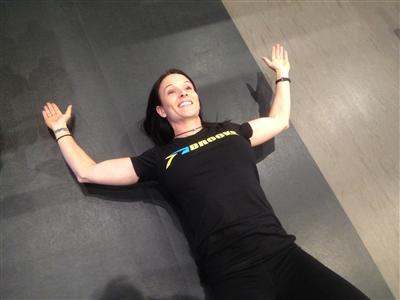We have already covered items related to the thoracic spine and shoulder girdle in our previous installments. In this, the final in our 3-part series, “Restoring Proper Posture,” we will explore the head and neck as we continue to discuss how you can restore proper posture and alleviate common physical stress and strain.
Restoring Proper Posture, Part 3: Head and Neck
The two most common postural deviations for the head and neck are forward head and excess cervical lordosis (Price, J. Pt on the Net, Oct 2008). Both of these postural concerns often result from excess rounding of the thoracic spine. Think of the head as a bowling ball sitting on a shelf. If the shelf the bowling ball sits on is not level, the bowling ball will roll forward. In this case, the head moves forward and neck increases its lordotic curve to maintain our line of sight so that is level with the horizon. Unfortunately, these postural compensations lead to increased stress on the neck musculature and the supporting structures in the spine and discs. The head weighs about 10-12lbs. A forward head at 1-1.5 inches beyond normal increases the stress to the neck and upper back to 32lbs and a forward head at 3-4 inches equates to roughly 42 lbs of additional stress. This constant stress will eventually overwhelm the muscles in the back of the head and neck which increases the risk for muscular aches and strain, disc degeneration, bulging/herniated discs and pinched nerves (Dr. Mandell, A. Quick fix to Forward Head Posture (Damaging Effects) Comprehensive, May 2015).
In order to support the head and neck in its proper position, the thoracic spine must also be properly positioned as well. To identify this, stand against a wall with your heels, hips and shoulder blades touching the wall while keeping the back of the head about a 1/3 inch away. Ideally, the line of sight should be level with the horizon and the ears should sit directly above the front of the shoulders. An imaginary line can be drawn from the cheek bone to the collar bone. If the line falls in the front of the collarbone, the head is forward. If the line of sight is not parallel with the floor, the neck will have excess lordosis (Price, J. Pt on the Net, Oct 2008).
 To help restore balance to the head, neck and shoulder girdle, the supine wave goodbye exercise may be used:
To help restore balance to the head, neck and shoulder girdle, the supine wave goodbye exercise may be used:
Lie in a face up position on the floor with the arms at shoulder height, elbows bent and the back of hands toward the floor. The shoulders should pull down toward the ground while also drawing them down toward the hips. Place a foam roller or stack some towels under the hands so that pressure can be applied thereby strengthening the muscles of the shoulder girdle. With the head, keep the chin tucked and the line of sight perpendicular to the ceiling. This will strengthen the muscles in the front of the neck while helping to lengthen the muscles from behind, thereby helping to reduce the excess curvature in the neck. This exercise can be performed daily using 6-10 reps with a 5-10 second isometric hold. (Price, J. Pt on the Net, Oct 2008).
We hope that you have found our series on restoring proper posture to be helpful and that you will put some or all of the exercises contained within to work for you. Please let us know what kind of difference this has made on your case day comfort. Sightpath continues to be committed to providing benefits beyond case day to our customers, be sure to follow our blogs and check back often for new tips and tricks to help make your case day a success.
This is part of a 3-part series about restoring proper posture. Check out the other installments below: